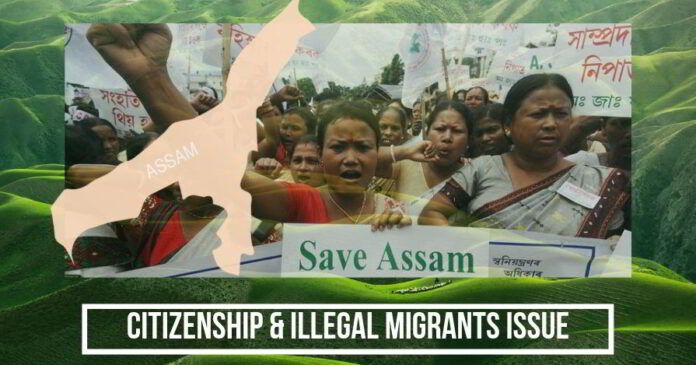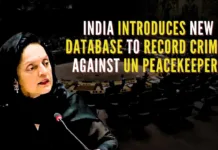
Illegal migration from Bangladesh is the most volatile and contentious issue in the country today
Citizenship:
Whenever we say Citizenship, it constitutes the indispensable foundational principle of a democratic polity. It is a legal product. So far as India is concerned Citizenship Rights had started only with the advent of Independence. After the commencement of the Indian Constitution on 26th January 1950 the matter of Citizens came into the picture. And eventually, on 5th August 1955, Citizenship Bill introduced in Lok Sabha. Then, it has come into force on 30th December 1955 known as ‘The Citizenship Act 1955’. It is an act to provide for acquisition and determination of Indian citizenship. So, one can become Citizen of India by birth, by descent, by registration and by naturalisation under this act. It also made necessary provisions for the termination and deprivation of citizenship under certain circumstances.
Large scale illegal migration from Bangladesh over several decades has been altering the demographic complexion of this State which poses a grave threat to the people of Assam and most importantly to our National Security
From the last few months, widespread protests against the Citizenship Bill continued in Assam with agitators blocking roads and marching with their clothes off. This whole citizenship issues emerged with the large scale illegal migration from East Pakistan/Bangladesh over several decades has been altering the demographic complexion of this State.
Illegal Migrants:
India has been witnessing immigration since Independence. Of all kinds of migration, Illegal migration from Bangladesh is the most volatile and contentious issue in the country today.
Illegal migration from Bangladesh into Assam has to view against the backdrop of past history, present realities and future designs. After the conquest of Assam in 1826, the British started establishing their control over the territory and exploiting its vast natural resources. At that time Assam was a part of the Bengal Presidency. The discovery of Tea in Assam resulted in peopling the state with tribal brought in from other parts of India to work as labourers in the large British owned tea estates. The British also encouraged Bengali Muslim peasants from present Bangladesh to move into lower Assam for putting virgin land under cultivation. This paved the way for illegal migration continued until today (even after Independence).
When Lord Curzon partitioned Bengal Presidency in 1905, Assam was a Chief Commissioner’s province. It was merged with the new Muslim majority province of East Bengal. In 1911, the British government annulled the partition of Bengal. Assam was restored its status as a province and was placed under Lieutenant Governor. The Muslim League now comes up with its demand for partition, on the basis of religion. During Mohammad Sadulla’s Muslim League Ministry, a concerted effort was made to encourage the migration of Bangladeshi Muslims into Assam for political reasons. Before partition, it was planned by the Mr Moinul Haque Choudhury, the Private Secretary of Jinnah who after Independence became a Minister in Assam and promised Jinnah that he would “present Assam to him on a silver platter”. However, this plan was foiled and Assam was saved from becoming a part of Pakistan.
Partition (based on religion) brought about a sea change in the situation. Population movement from East Pakistan continued but it was mostly of Hindu refugees, fleeing from religious persecution. However, unlike the west, in East this spread over several years and still is continuing. And the worst part is along with Hindu refugees, Muslim infiltrators continued migrating into Assam for economic reasons. If we look back and analyse the history of Bangladesh, India supported and helped in giving independence to Bangladesh by supporting Sheikh Mujibur Rahman (who was always known as Pro-Indian Leader). Having said this no matter how friendly our relations with Bangladesh, one cannot afford to ignore the dangers inherent in a demographic invasion from that country.
Large scale illegal migration from Bangladesh over several decades has been altering the demographic complexion of this State which poses a grave threat to the people of Assam and most importantly to our National Security. There is a danger arising out from this silent demographic invasion. The long cherished design of Greater East Pakistan making inroads into the strategic land link of Assam with the rest of the country and could lead to severing the entire land mass of North-East, with all its rich resources, from the rest of the country.
We should remember the fact that in 1947 our nation divided primarily on the basis of religion with no fault of citizens
Besides economic reason, most significant contributory factors facilitating infiltration from Bangladesh was of Political Party reigning at that period with a view to building vote banks. Moreover, with corruption being all pervasive, corrupt officials, are bribed to provide help. In fact, then CM of Assam while addressing a rally in Nagaon district of Assam claimed there was not a single Bangladeshi National in the state. (Source: India Today, Dec. 2. 2012).
Lots of movement has taken place in the past such as Assam Movement against the illegal migrants in Assam led by All Assam Students Union (AASU) and the All Assam Gana Parishad (AGP) and developed a program of protests and demonstration to compel the government to identify and expel illegal immigrants. The Nelie Massacre and Khoirabari Massacre were some cases of extreme violence. This agitation program ended in August 1985 following the Assam Accord. The agitation leaders formed a political party, Asom Gana Parishad and led Prafulla Kumar Mahanta to be elected as the youngest CM of the State. It is to be noted that the AGP has formed government twice from 1985 to 1989 and from 1996 to 2001 and AGP, was a result of a six years long Assam Agitation against illegal infiltration of foreigners from Bangladesh into Assam. One can say clearly see that it is the lack of conviction among the leaders of our State that even powers and chairs could not solve the problems of illegal migrants.
In a present day, the dangerous consequences of large scale illegal migrants from Bangladesh, both for the people of Assam and more for the Nation as a whole, need to be emphatically stressed. No misconceived and mistaken notions of secularism should be allowed to come in the way of doing so.
A Report on Illegal Migration into Assam submitted to the President of India by the then Governor of Assam by Lt. Gen (Retd.) S.K.Sinha, on 8th No. 1998 showed:
| Year | Assam | All | |||
| Hindus | Muslims | Hindus | Muslims | ||
| 1 | 1951-1961 | 33.71 | 38.35 | 20.29 | 25.61 |
| 2 | 1961-1971 | 37.17 | 30.99 | 23.72 | 30.85 |
| 3 | 1971-1991 | 41.89 | 77.42 | 48.38 | 55.04 |
(Source: Report on Illegal Migration into Assam; Submitted to the President of India)
If one studies the above data it can be easily be seen that the Muslim population of Assam has shown a rise of 77.42% in 1991 from what it was in 1971. Hindu population has risen by nearly 41.89% in this period. The Muslim population has been in Assam has risen from 24.68% in 1952 to 28.42% in 1991. As per 1991 census, four districts namely Dhubri, Goalpara, Barpeta and Hailakandi have become Muslim majority district. And According to the 2011 census now even Karimganj District reached to 56.36% and Hindus declined to 42.48%. Same condition with Nagaon district (Muslim 55.36%; Hindu 43.39%).
It can easily be found out that, as a result of population movement from Bangladesh, the spectre looms large of the native people of Assam being reduced to a minority in their own homeland.
Accordingly, the present government introduced the Present Citizenship Amendment Bill 2016 which is granting citizenship by naturalisation. The requirement for citizenship by naturalisation is that applicant must have resided in India during the last 12 months, and for 11 of the previous 14 years.
Now, the Bill relaxes this 11-year requirement to 6 years for persons belonging to minority namely, Hindus, Sikhs, Buddhists, Jains, Parsis and Christians from Afghanistan, Bangladesh and Pakistan, who were forced to leave their countries because of religious persecution.
The Bill also said that those persons who have entered into India on or before 31.12.2014 are only provided with a facility to apply for naturalisation subject to the other laws for the time being in force and they are not given citizenship straightway.
We should remember the fact that in 1947 our nation divided primarily on the basis of religion with no fault of citizens. After the partition, where India decided to become a secular state at the same time Pakistan and Bangladesh decided to become a theocratic state. This has resulted in the religious persecution of many minorities which continued till date. They were forced to suffer socially and politically and ultimately they were displaced from their native place.
it was the duty of the Government that before bringing up this Bill on the table there should have a proper awareness via different medium to the mass level
Protest against the Citizenship Bill in Assam:
Since after the proposal of the Amendment of Citizenship Bill, lots of resistance, and even nude protest erupted in the State. It is reported about 70 indigenous organisation including AGP & AASU launched a campaign against the Bill. People of Assam feel threatened of losing their cultural and linguistic identity. It is also a fear that after the implementation, there will be a sudden influx of Bangladeshi Hindu in the State, which may jeopardise their existence politically and economically. Because most of the Hindu Bangladeshi will be Bengali speaking. So, the entire protest became a part of fighting for their identity.
The genesis of this problem started in 1826 with the British annexation. It marked not only the end of the independent and powerful Ahom monarchy but ushered in a new regime of foreign domination. The British annexed the state of Assam and placed it under the Bengal administration (1826-1873). The Assamese language which has a long history of its existence in the absence of the schools, however, was not taught as a subject in the modern sense of the term, prior to British Rule. The Assamese intelligentsia of the Pre-British periods was much influenced by Sanskrit and also to some extent by Persia which was at that time the court language of India (Majumdar: 11).
In 1837, to help the British in consolidating their power in Assam, a large number of Bengalis were brought from Bengal, the immediate neighbour of Assam. And in 1837, eventually, the Bengali became the instruction and in the courts of Assam and it is continued for quite long years. Although for more than 10 years after the annexation of the province, Assamese was the language of the courts, as the part of the Presidency of Bengal. This situation affected the province which is led to the continuous conflict between the Bengalis and the Assamese. The increased number of Bengalis in government jobs in a different district of Assam might pose a challenge to the distinct identities of Assamese people because Bengalis has their own culture, language and traditions.
On the other hand Bengali Muslims did not pose many problems because of a tacit understanding and they are keen on improving their economy a lot and appeared to have reached with the Assamese on language issue, by getting land in fertile valley and by offering their cheap labour in the struggle for survival, the immigrants put their love of language and declared Assamese as their mother-tongue. (It is to be noted that for Muslims, language was never a concern they accumulate different language as per their convenience like in Manipur they speak Metei). Initial protests against the government’s language policy came from the American Baptist Missionaries and the educated Assamese elite section (as Missionaries needed vernacular medium to spread Christianity). Disseminating western thoughts and learning for over twenty years inspired the Assamese youths for a separate identity and paved the way for breaking Assam sophistically.
If we talk about the history of Assam it speaks of the traditions and cultures of the oldest periods of human civilisations. Enriched by many Dynastic traits, the land of Assam remains one of the most enticing states of India. We should remember Assam is a multiethnic and multi-Lingual State. The infiltration anxiety and anger is so strong in the present day that it has often led to ethnic tensions and violence amongst the people of the State. Sadly, the seed of divisions that sowed by the British still continued. Political Parties also never dedicated to coming into the integration part. And the undivided Assam divided into many. Now, Bodos are demanding for separate Statehood. Even, Dima Hasao District is heading for a territorial council. Tiwa, Sonowal Kacharis have their own distinctive Autonomous Council now.
We should not fight over our sub-identity. Moreover, nobody wants to leave their land and property until and unless if there is a death threat. India always welcomes those who were persecuted in their country for an ethnic and religious reason and who are friendly to India be it Jewish, Parsis, Tibetan etc. Even, lots of Chakma, Hmars took shelter in Assam after driven out from different places at different point of time.
However, I believe that here, it was the duty of the Government that before bringing up this Bill on the table there should have a proper awareness via different medium to the mass level. Because we are living in an Information Age where information can be misinterpreted very easily. In addition to that, the Government must act strongly against those Nations where Hindus are being persecuted violently.
The worst part is in this scenario is even educated and learned people of our Society failed to understand the crux of the matter and they made no effort to make people understand the root cause of the issue.
A Continuing Civilisation:
We belong to a civilisation which never tried to claim superiority in the world nor had a bloody invasion history. No one can deny the fact that the word ‘Hindu’ always associated with this land only. It is said the Persians used to refer to the Indus River as ‘Sindhu’ and from it became ‘H’indu (as they could not pronounce ‘S’). So, people living beyond the river Sindhu River to the North and till the Indian Ocean known as Hindu by foreigners’ invaders and foreign travellers. And the people of this land follow “Sanatan Dharma” (for correct technical connotation) not Hindu (as it was never a religion).
The north-eastern part of India has been remaining a challenging region in terms of economic development, social, cultural and integration. And the most disturbing factor is the alienation part. The cultural and commercial ties that existed in ancient times were segregated by the British policy. The neighbours became strangers. Additionally, religious conversion and separatism played a pivotal role in all these affairs.
Historically, Assam is the confluence of people from the east, west, and the north. It was included the current states of Arunachal Pradesh, Meghalaya, Nagaland and Mizoram. The capital of this state was Shillong (currently capital of Meghalaya). Prior to the Partition of India, even Sylhet was a part of India and it is used to call as a ‘Greater Assam’ or Undivided Assam. You can say the present day population of Undivided Assam will be approximately 50 million slightly less than the population of South Korea. Honestly, we actually shrunk as a State. Since the restructuring of Assam after Independence, communal tension and violence remain. Numbers of Separatist group, Insurgency group forming along ethnic lines, and demands for autonomy and sovereignty grew, resulted in the fragmentation of Assam.
Conclusion:
From the last few years, I am witnessing lots of fights over languages, the ethnic matter which is leading towards lots of tussle amongst the people of Assam. The worst part is in this scenario is even educated and learned people of our Society failed to understand the crux of the matter and they made no effort to make people understand the root cause of the issue. Some are demanding to carve out themselves from the Country or some are bashing the government. We have always been carried away by foreign jargon like Nationalism, which talked about one race, one community, homogeneity. We should have our own version of Nationalism and need to realise that this land was never a homogenous nation. It was a multi-lingual, multi-cultural, multi-sect (unlike European Nation). And this was always a matter of wonder for foreigners to understand how this Nation growing, thriving and surviving together with so many differences. Assam is a land of many different ethnic communities who are contributing to the development from a historical period. But, if we keep fighting over sub-identity I am afraid we will shrink more. No country is flourished after separated from India. I hope we shall learn from our history. I hope the readers will able to connect all the dots and think for a reasonable way out. We have to learn to live with diversity without compromising our Dharmic Civilisation. In the 21st Century, it is the responsibility of the intellectual community to bring that solidarity amongst the people.
“I am a survivor of a concentration camp. My eyes saw what no person should witness…………..
Help Your Children become Human. Your efforts must never produce learned monsters or skilled psychopaths. Reading, writing and arithmetic are important only if they serve to make our children more human” – Dr Haim Ginott, Child Psychologist and Holocaust Survivor.
Note:
1. The views expressed here are those of the author and do not necessarily represent or reflect the views of PGurus.
- Racial Discrimination on NE people ; myth or reality - May 13, 2020
- Citizenship & Illegal Migrants Issue - February 24, 2019
- India – A Hub of Cow Slaughter houses - November 11, 2018










